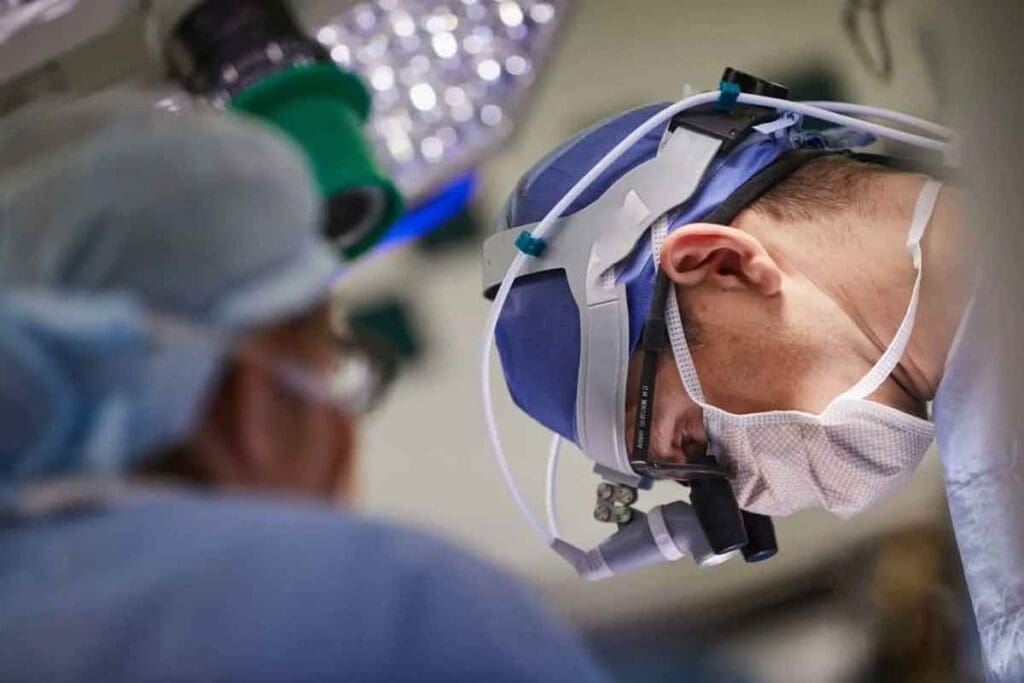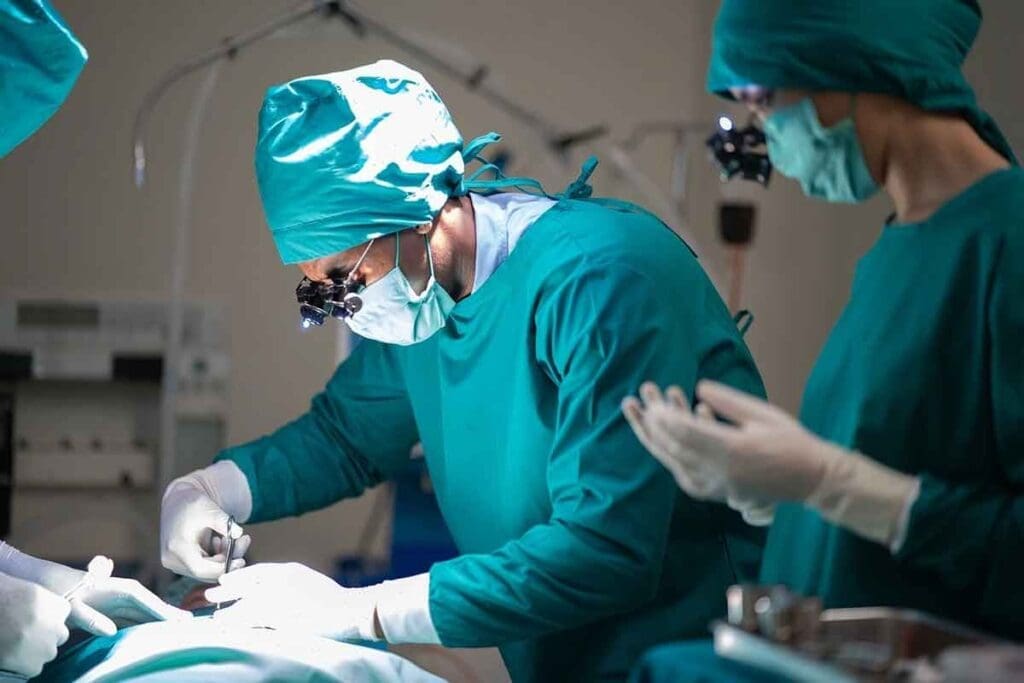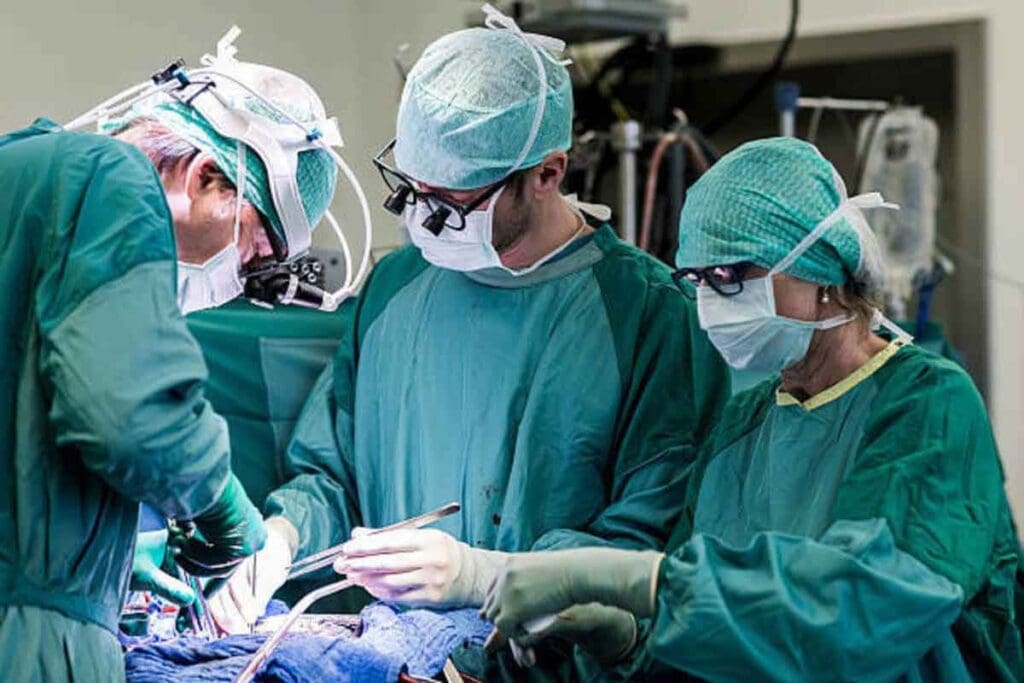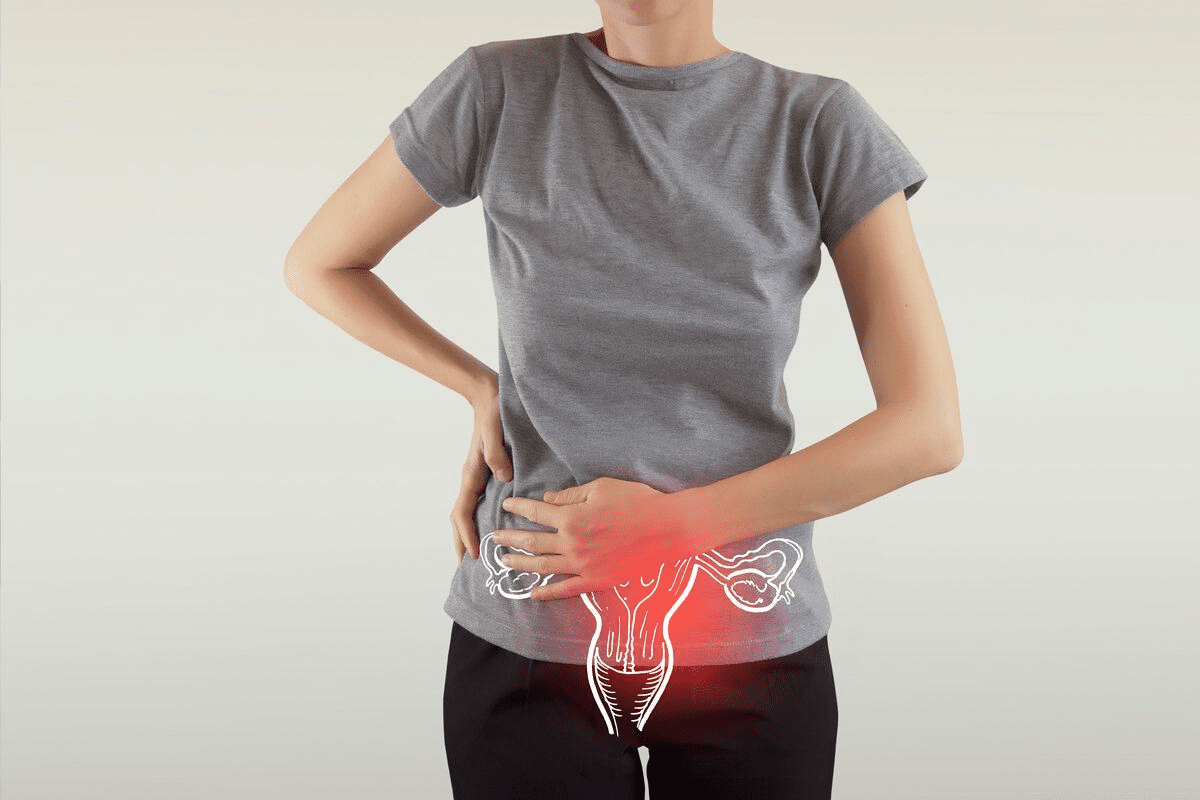Last Updated on November 26, 2025 by Bilal Hasdemir

Endovascular aneurysm repair (EVAR) is changing how we treat aortic aneurysms. It’s minimally invasive and very effective. EVAR uses stent grafts to fix the aneurysm, lowering the chance of rupture and improving results for patients.
Liv Hospital’s team is leading in this new treatment. They offer reliable care and the newest technology to their patients. Choosing EVAR means patients get shorter recovery times and less chance of complications.
Key Takeaways
- Endovascular aneurysm repair (EVAR) is a minimally invasive procedure for treating aortic aneurysms.
- EVAR involves the use of stent grafts to repair the aneurysm, reducing the risk of rupture.
- Liv Hospital’s expert team delivers trustworthy care and the latest technology to patients.
- EVAR offers shorter recovery times and reduced risk of complications compared to traditional surgery.
- Patients can benefit from improved outcomes and reduced risk of mortality with EVAR.
Understanding Aortic Aneurysms: A Brief Overview

It’s important to know about aortic aneurysms to spot and treat them early. This condition is serious and needs a deep understanding for the right treatment.
What is an Aortic Aneurysm?
An aortic aneurysm happens when a part of the aorta gets weak and bulges. This bulge can be deadly if it bursts. So, finding and treating it quickly is key.
Types of Aortic Aneurysms
Aortic aneurysms are divided by where they happen in the aorta. The main kinds are:
- Abdominal Aortic Aneurysms (AAA): Found in the belly part of the aorta.
- Thoracic Aortic Aneurysms (TAA): In the chest area.
- Thoracoabdominal Aortic Aneurysms: Stretch from the chest to the belly.
Risk Factors and Prevalence
Things like smoking, high blood pressure, and family history can raise your risk. Knowing these risk factors helps prevent and catch aneurysms early.
How common aortic aneurysms are can vary. Some groups are more at risk because of their genes or lifestyle.
Traditional Open Surgery for Aortic Aneurysms

Open surgery for aortic aneurysms is a long-standing method. It requires a big cut in the belly or chest. This approach has been around for decades to fix aortic aneurysms by directly working on the aorta.
The Open Surgical Approach
The open surgery method needs a big cut to reach the aorta. Surgeons then fix the aneurysm by clamping the aorta. They open the aneurysm sac and replace it with a synthetic graft.
Limitations and Risks of Open Surgery
Open surgery is effective but comes with risks. It has a higher chance of complications and more blood loss than endovascular repair. Risks include infection, breathing problems, and heart issues.
Here’s a table comparing the risks and limitations:
| Complications | Open Surgery Risks |
| Infection | Higher risk due to larger incision |
| Blood Loss | Significant loss during and after surgery |
| Cardiac Issues | Increased risk of heart-related complications |
| Recovery Time | Longer recovery period, often several months |
Recovery Timeline After Open Surgery
Recovering from open surgery for aortic aneurysms takes a long time. Patients usually stay in the hospital for days and need months to fully get better. The recovery involves managing pain, watching for complications, and slowly getting back to normal.
Key aspects of the recovery timeline include:
- Hospital stay: usually 7-10 days
- Pain management: critical in the initial recovery phase
- Follow-up care: regular check-ups to monitor healing
- Return to activities: gradual resumption of normal activities over several months
What Is the New Surgery for Aortic Aneurysm: Introducing EVAR
Endovascular Aneurysm Repair (EVAR) is a new surgery for aortic aneurysms. It’s a minimally invasive procedure that’s less risky than traditional surgery. This method has changed how we treat aortic aneurysms.
Definition and Development of Endovascular Aneurysm Repair
EVAR is a procedure to treat aortic aneurysms without open surgery. It uses a stent graft inserted through the arteries in the groin. The stent graft expands to fit the aortic walls, excluding the aneurysm from blood flow.
The development of EVAR is a big step forward in vascular surgery. It started in the early 1990s. Now, EVAR is a safe and effective treatment for many patients.
The Rise of EVAR: Statistical Adoption Rates
EVAR has become very popular quickly. By 2010, 78 percent of all intact abdominal aortic aneurysm repairs in the United States used endovascular grafts and stents. This shows a big shift towards minimally invasive procedures.
The rise in EVAR shows its benefits. These include shorter recovery times and fewer complications. This makes EVAR a preferred choice for many.
The Revolution in Aortic Aneurysm Treatment
EVAR has changed how we treat aortic aneurysms. It offers a less invasive option than open surgery. This has led to better outcomes, including reduced morbidity and mortality rates.
EVAR has also made treatment available to more patients. It’s a big change in how we manage aortic aneurysms. Patients recover faster and can get back to their lives sooner.
How Endovascular Repair Works: The Procedure Explained
Endovascular repair is a big step forward in treating aortic aneurysms. It’s less invasive than traditional surgery. This method can help patients recover faster and face fewer complications.
What Does Endovascular Mean?
“Endovascular” means using small incisions to access blood vessels. This is different from big cuts. For aortic aneurysm repair, doctors use arteries in the groin to reach the aneurysm. They use special tools and images to guide them.
Endovascular aneurysm repair (EVAR) is a key example. It involves placing a stent-graft through small cuts. This graft reinforces the weak part of the aorta.
Step-by-Step EVAR Procedure
The EVAR procedure has several steps:
- Doctors make small cuts in the groin to access arteries.
- They use guidewires and catheters to reach the aortic aneurysm.
- A stent-graft is placed in the aorta to block blood flow to the aneurysm.
- They check to make sure the stent-graft is working right.
- Then, they close the groin cuts.
This whole process is guided by imaging, like fluoroscopy. It helps place the stent-graft exactly right.
The Aneurysm Sac: Treatment and Exclusion
A big part of EVAR is stopping blood flow to the aneurysm sac. This reduces pressure on the aortic wall. Over time, it can make the aneurysm smaller and lower the risk of rupture.
Keeping the aneurysm sac out of circulation is key for EVAR’s success. It’s important to watch for any problems, like endoleaks, after the procedure.
Stent Grafts: The Technology Behind Endovascular Repair
Stent grafts are key in endovascular repair, providing a less invasive fix for aortic aneurysms. They are delivered through a catheter to reinforce the aorta. This makes them a strong and effective treatment choice.
Aortic Stent Types and Materials
Stent-grafts are made from metal and synthetic materials. They are designed to strengthen the aorta’s weak spots. The material and design depend on the patient’s needs and the aneurysm’s specifics.
Materials like nitinol are chosen for their flexibility and strength. Polyester and PTFE are used for their ability to work well with the body.
Abdominal Aortic Aneurysm Stenting Devices
Devices for treating abdominal aortic aneurysms are made to fit each patient. They come in various sizes and shapes. The Zenith and Excluder stent grafts are among the FDA-approved options.
Endovascular Grafts: Design and Function
The design of endovascular grafts is vital to their success. They are made to be deployed through a catheter, allowing for a minimally invasive procedure. Once in place, they expand to match the aorta’s size.
This effectively blocks blood flow to the aneurysm, reducing the risk of rupture.
Customization for Patient Anatomy
Modern stent graft technology allows for customization based on patient anatomy. This involves detailed measurements of the aorta and aneurysm. It helps choose or design a stent graft that fits perfectly, leading to better outcomes.
Types of Endovascular Procedures for Different Aortic Aneurysms
Aortic aneurysms can be treated in different ways, thanks to new endovascular procedures. These methods are tailored to fit each aneurysm’s unique needs. This approach helps improve patient outcomes.
EVAR for Abdominal Aortic Aneurysms
Endovascular Aneurysm Repair (EVAR) is a common treatment for abdominal aortic aneurysms (AAAs). It involves placing a stent graft in the aorta. This keeps the aneurysm from growing and reduces the risk of rupture.
EVAR is less invasive than traditional surgery. It leads to quicker recovery times and fewer complications. Many patients find it a better option for treating AAAs.
TEVAR for Thoracic Aortic Aneurysms
Thoracic Endovascular Aortic Repair (TEVAR) treats thoracic aortic aneurysms. Like EVAR, it uses a stent graft in the thoracic aorta to exclude the aneurysm.
TEVAR is great for those at high risk from open surgery. It’s a less invasive choice with fewer risks during and after the procedure.
New Procedures for Ascending Aortic Aneurysms
Ascending aortic aneurysms are tricky to treat because of their location. New endovascular methods are being explored for these aneurysms. These are in the early stages and not widely used yet.
These new procedures aim to offer less invasive options for those who can’t have traditional surgery. But, more research is needed to prove their safety and effectiveness.
TAAA Surgery: Treating Thoracoabdominal Aneurysms
Thoracoabdominal aortic aneurysms (TAAAs) affect the aorta in both the chest and belly. TAAA surgery combines endovascular and open surgery techniques. It’s a complex way to treat these extensive aneurysms.
| Procedure | Aneurysm Type | Key Features |
| EVAR | Abdominal Aortic Aneurysm | Minimally invasive, stent graft placement |
| TEVAR | Thoracic Aortic Aneurysm | Less invasive, reduced perioperative risk |
| TAAA Surgery | Thoracoabdominal Aortic Aneurysm | Complex, often multi-stage procedure |
Benefits of Endovascular Repair Compared to Open Surgery
Endovascular repair has changed how we treat aortic aneurysms. It offers many benefits over traditional open surgery. This method is less invasive and preferred by many patients.
Reduced Operative Risks
EVAR reduces the risks of surgery. It doesn’t need a big cut in the belly. This is great for those at high risk for surgery problems.
Minimized Blood Loss
EVAR causes less blood loss than open surgery. Its minimally invasive nature lowers bleeding risks. This is key for those on blood thinners or with bleeding issues.
Shorter Hospital Stay
Patients after EVAR stay in the hospital less time. This means they can get back to their lives faster. They spend less time away from family and work.
Quicker Recovery Time
Recovery from EVAR is faster than open surgery. Patients can get back to their daily routines in weeks, not months. This is a big plus for those needing to get back to work.
In summary, EVAR’s benefits are clear. It offers less risk, less blood loss, shorter hospital stays, and quicker recovery. As technology advances, EVAR will likely improve patient care even more.
Patient Selection and Real-World Outcomes
Endovascular aneurysm repair (EVAR) has changed how we treat aortic aneurysms. But, not every patient can have this procedure. The success of EVAR depends on the patient’s health, the aneurysm’s size and shape, and its location.
Who Is a Candidate for Endovascular Repair?
Most people with abdominal aortic aneurysms (AAA) can get EVAR. This is true for those with an aneurysm of 5 cm or bigger. Whether EVAR is right for you depends on the aneurysm’s size, shape, and where it is. It also depends on your blood vessels.
Key criteria for EVAR candidacy include:
- An aneurysm diameter of 5 cm or more
- Favorable aortic neck anatomy
- Access vessels that are not too tortuous or narrow
- No significant contraindications such as severe kidney disease or allergy to contrast agents
Success Rates and Clinical Outcomes
Many studies show EVAR is effective for treating aortic aneurysms. The success rate is high, leading to fewer deaths from aneurysms.
| Study | Success Rate | Follow-up Period |
| EVAR Trial 1 | 94% | 4 years |
| OVER Trial | 96% | 5 years |
| French National Registry | 93% | 3 years |
Patient Experiences with Endovascularly Treated Aneurysms
Patients who get EVAR often recover faster than those who have open surgery. They can usually get back to their normal life in just a few weeks.
“I was back on my feet within a week after the procedure, and I was amazed at how quickly I recovered.” – John D., EVAR patient
Contraindications for EVAR
Even though EVAR works for many, there are times when it’s not the best choice. This includes complex aortic anatomy, severe kidney disease, and allergies to contrast agents used during the procedure.
By carefully choosing who gets EVAR and knowing how it works in real life, doctors can make better treatment plans for patients with aortic aneurysms.
Potential Complications and Long-term Monitoring
Endovascular aneurysm repair (EVAR) has changed how we treat aortic aneurysms. It’s less invasive than open surgery but comes with risks. It’s important to watch patients closely over time.
Endoleaks: Types and Management
Endoleaks are a big worry with EVAR. They happen when blood leaks into the aneurysm sac around the stent graft. There are different types, each needing its own treatment plan.
Type I endoleaks happen when the stent graft doesn’t seal well. Type II endoleaks come from blood flowing back into the aorta. Type III is when the graft fails. Finding and treating endoleaks quickly is key to avoiding serious problems.
Stent Migration and Other Device-Related Issues
Stent migration is another issue with EVAR. It’s when the stent moves from where it was placed. This can cause leaks or make the aneurysm sac not work right. It’s important to check the stent’s position and condition regularly.
- Stent graft migration
- Endoleaks
- Graft thrombosis
Other problems, like stent fracture or kinking, can also happen. Newer stent grafts are designed to reduce these risks.
Follow-up Protocol After Endovascular Repair
Watching patients closely after EVAR is key. They get regular scans, like CT scans, to check the stent graft and the aneurysm sac. The follow-up plan depends on the patient’s risk factors and the procedure details.
Patients usually have scans at 1, 6, and 12 months after the procedure. Then, they get checked every year. Sticking to this schedule helps catch any problems early.
In summary, EVAR is a great way to treat aortic aneurysms, but it has risks. Keeping an eye on patients long-term is vital for their health and the success of the procedure.
Conclusion: The Future of Aortic Aneurysm Treatment
The treatment of aortic aneurysms has seen big changes with endovascular repair (EVAR). This new method is safer than old surgery ways. Now, EVAR is the top choice for many aortic aneurysm treatments.
The future of treating aortic aneurysms is bright. EVAR technology and methods are getting better. We’ll see better stent grafts and materials soon. This means better care for more patients.
EVAR is leading the way in treating aortic aneurysms. Thanks to new ideas and research, patients will get even better care. They can look forward to a better life.
FAQ
What is an aortic aneurysm?
An aortic aneurysm is a bulge in the aorta. The aorta is the main blood vessel that carries blood from the heart to the rest of the body.
What is endovascular aneurysm repair (EVAR)?
EVAR is a minimally invasive surgery for aortic aneurysms. It involves placing a stent graft in the aorta. This graft excludes the aneurysm sac from blood flow.
What does endovascular mean?
Endovascular means a procedure done inside the blood vessels. It uses a minimally invasive approach with small incisions.
How is EVAR performed?
EVAR starts with small incisions in the groin. A stent graft is inserted and guided to the aorta. Imaging techniques help place it correctly.
What are the benefits of EVAR compared to open surgery?
EVAR has many benefits. It reduces risks, blood loss, and hospital stay. Recovery is also quicker, making it a popular choice.
What are the types of endovascular procedures for different aortic aneurysms?
There are several endovascular procedures. EVAR treats abdominal aortic aneurysms. TEVAR is for thoracic aortic aneurysms. New procedures address ascending aortic aneurysms. TAAA surgery is for thoracoabdominal aneurysms.
What is a stent graft?
A stent graft is used in EVAR. It’s a metal stent covered with a graft material. It’s designed to be durable and long-lasting.
What are the possible complications of EVAR?
EVAR complications include endoleaks and stent migration. These issues require ongoing monitoring to ensure the graft’s function.
How is an aneurysm sac treated and excluded during EVAR?
EVAR excludes the aneurysm sac from blood flow. The stent graft prevents further blood flow into the sac, reducing rupture risk.
What is the follow-up protocol after endovascular repair?
Post-EVAR follow-up includes regular imaging studies. CT scans monitor the graft’s integrity and function. They also detect complications.
Who is a candidate for endovascular repair?
EVAR candidates have aortic aneurysms suitable for the procedure. They are at high risk for open surgery or prefer a minimally invasive approach.
What are the contraindications for EVAR?
EVAR contraindications include complex aortic anatomy and certain medical conditions. These make the procedure risky or unsuitable.
References
- Puttini, I., Kapalla, M., Braune, A., Michler, E., Kröger, J., Lutz, B., … & Busch, A. (2024). Aortic Vascular Graft and Endograft Infection—Patient Outcome Cannot Be Determined Based on Pre-Operative Characteristics. Journal of Clinical Medicine, 13(1), 269. https://pmc.ncbi.nlm.nih.gov/articles/PMC10823419/






